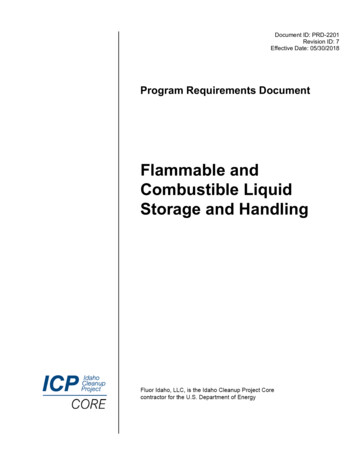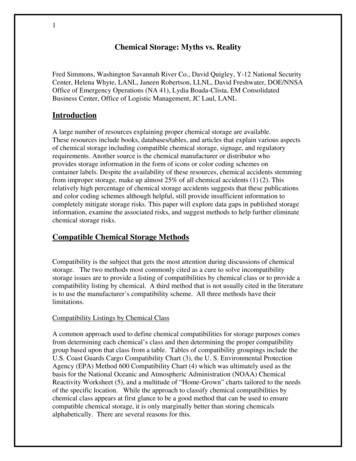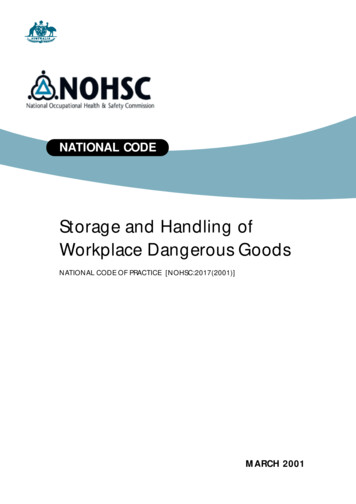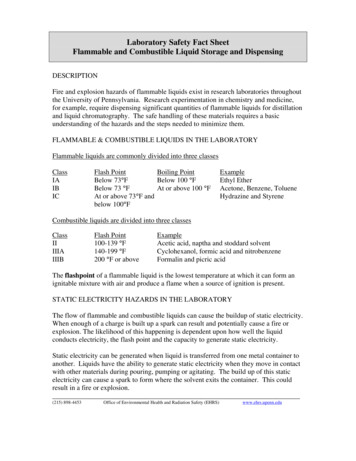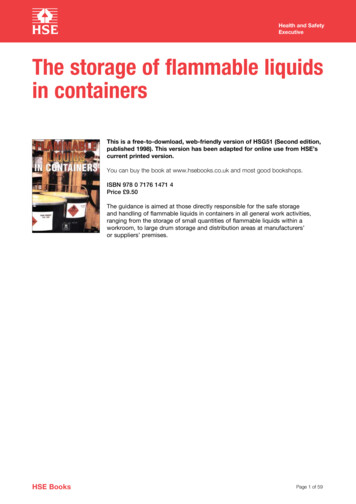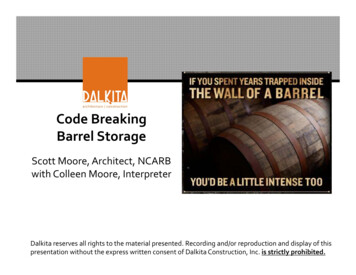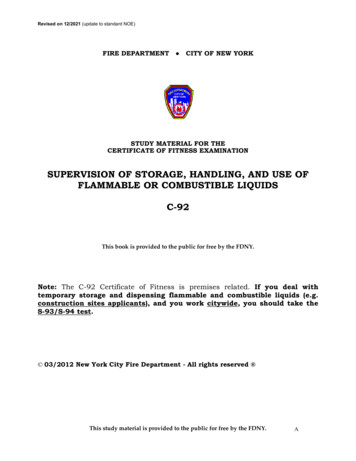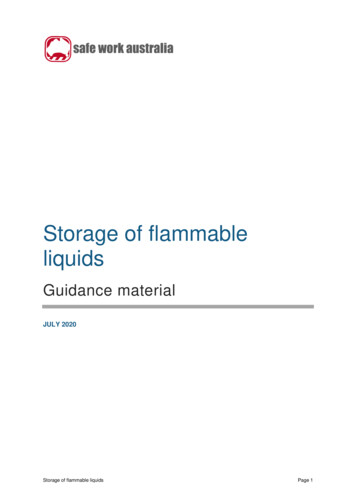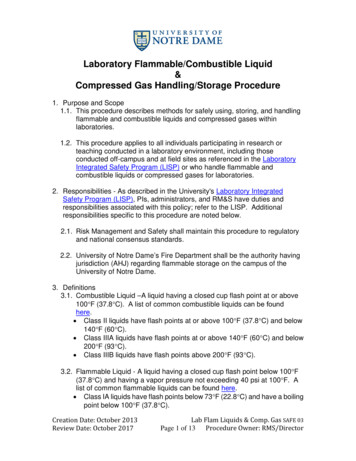
Transcription
Laboratory Flammable/Combustible Liquid&Compressed Gas Handling/Storage Procedure1. Purpose and Scope1.1. This procedure describes methods for safely using, storing, and handlingflammable and combustible liquids and compressed gases withinlaboratories.1.2. This procedure applies to all individuals participating in research orteaching conducted in a laboratory environment, including thoseconducted off-campus and at field sites as referenced in the LaboratoryIntegrated Safety Program (LISP) or who handle flammable andcombustible liquids or compressed gases for laboratories.2. Responsibilities - As described in the University's Laboratory IntegratedSafety Program (LISP), PIs, administrators, and RM&S have duties andresponsibilities associated with this policy; refer to the LISP. Additionalresponsibilities specific to this procedure are noted below.2.1. Risk Management and Safety shall maintain this procedure to regulatoryand national consensus standards.2.2. University of Notre Dame’s Fire Department shall be the authority havingjurisdiction (AHJ) regarding flammable storage on the campus of theUniversity of Notre Dame.3. Definitions3.1. Combustible Liquid –A liquid having a closed cup flash point at or above100 F (37.8 C). A list of common combustible liquids can be foundhere. Class II liquids have flash points at or above 100 F (37.8 C) and below140 F (60 C). Class IIIA liquids have flash points at or above 140 F (60 C) and below200 F (93 C). Class IIIB liquids have flash points above 200 F (93 C).3.2. Flammable Liquid - A liquid having a closed cup flash point below 100 F(37.8 C) and having a vapor pressure not exceeding 40 psi at 100 F. Alist of common flammable liquids can be found here. Class IA liquids have flash points below 73 F (22.8 C) and have a boilingpoint below 100 F (37.8 C).Creation Date: October 2013Review Date: October 2017Lab Flam Liquids & Comp. Gas SAFE 03Page 1 of 13 Procedure Owner: RMS/Director
Class IB liquids have flash points below 73 F (22.8 ) and have a boilingpoint above 100 F (37.8 C).Class IC liquids have flash points at or above 73 F (22.8 C) and below100 F (37.8 C).3.3. Hazardous Locations – These areas are separated by classes, divisions,and groups to define the level of safety required for electrical equipmentinstalled in these locations. There are 3 classes of hazardous locations: Class I – Hazardous because flammable gases or vapors are presentin the air in quantities sufficient to produce explosive or ignitablemixtures. Class II – Hazardous because combustible or conductive dusts arepresent. Class III – Hazardous because ignitable fibers or flyings are present,but not likely to be in suspension in sufficient quantities to produceignitable mixtures. Typical wood chips, cotton, flax and nylon.3.4. HMIS Rating System – The Hazardous Materials Identification System(HMIS) is a numerical hazard rating that incorporates the use of labelswith color-coded bars. This is similar to the NFPA 704 System in that italso rates the health, fire and reactivity hazards of a chemical on a scaleof 0-4 where zero is minimal hazard and four is an extreme hazard. TheHMIS Rating System denotes the type of personal protective equipment(PPE) required for handling. It is denoted by the use of a rectangle that isdivided into 5 sections, the blue health hazard, a red for fire hazard, ayellow for reactivity, and the white for special PPE.Example HMIS Label3.5. Laboratory – As defined in the Laboratory Integrated Safety Program(LISP).Creation Date: October 2013Review Date: October 2017Lab Flam Liquids & Comp. Gas SAFE 03Page 2 of 13 Procedure Owner: RMS/Director
3.6. NFPA 704 System – A hazards identification system developed by theNational Fire Protection Association (NFPA). This system rates thehealth, fire and reactivity hazards of a chemical on a scale of 0-4 wherezero is minimal hazard and four is an extreme hazard. In addition thissystem notes special hazards such as acids, alkalis, corrosives, oxidizers,radioactives, or water reactives. It is denoted by the use of a diamondthat is divided into four boxes. The colors include: a blue box for healthhazard, a red box for fire hazard, a yellow box for reactivity, and a whitebox for special hazards.Example NFPA Label4. Flammable and Combustible Liquid Handling and Storage Requirements4.1. All flammable and combustible chemicals shall be stored in properlysealed, labeled containers. (Refer to Hazard Communication Plan)Creation Date: October 2013Review Date: October 2017Lab Flam Liquids & Comp. Gas SAFE 03Page 3 of 13 Procedure Owner: RMS/Director
4.2. Secondary containment shall be used whenever possible to minimize theflow of material during a spill or rupture.4.3. Incompatible chemicals shall be stored separate from each other andisolated by distance or barriers to prevent intermingling in the event of anaccidental spill. At a minimum, chemicals shall be separated according tosimilar hazards, such as flammability, corrosiveness, sensitivity to wateror air, and toxicity. Review the Chemical Hygiene Plan for additionalinformation and Table 3 in this document for segregation of compressedgas cylinders.4.4. Table 1 shows the maximum container size of flammable andcombustible liquids permitted by container type.4.4.1. For teaching laboratories, additional restrictions on Class I orClass II liquid containers shall not exceed the following capacity: Safety cans – maximum of 2 gallons (8 L) All other containers – maximum of 1 gal (4 L) unless a smallercontainer is noted.Table 1Maximum Container SizeNFPA 45IA1 pt*500 ml1 gal4L2.5 gal10 L1 gal4LIB1 qt*1L5 gal20 L5 gal20 L5 gal20 LIC1 gal4L5 gal20 L5 gal20 L5 gal20 LCombustibleLiquidIIIIIA/B1 gal5 gal4L20 L5 gal5 gal20 L20 L5 gal5 gal20 L20 L60 gal60 gal227 L227 L1 gal5 gal5 gal60 galFlammable LiquidContainer TypeGlassMetal (other than DOT Drums) orApproved PlasticSafety Cans (FM or UL)Metal Container (DOTSpecifications)Polyethylene Container(DOT Specifications 34, UN 1H1, or as4L20 L20 L227 Lauthorized by DOT Exemption)Table 1 Notes:* Glass containers as large as one (1) gallon (3.78 L) may be used if the purity would beadversely affected by storage in a metal or an approved plastic container or if the liquid wouldcause excessive corrosion or degradation of a metal or plastic container.60 gal227 LContact the University of Notre Dame’s Fire Department (Authority Having Jurisdiction) and theRisk Management and Safety Department if alternative container sizes are required.Creation Date: October 2013Review Date: October 2017Lab Flam Liquids & Comp. Gas SAFE 03Page 4 of 13 Procedure Owner: RMS/Director
4.5. The maximum quantities of flammable and combustible liquids within alaboratory are limited based on the material classification and thelaboratory’s location and function. Refer to Table 2 for liquids.Table 2Maximum Quantities of Flammable and Combustible Liquids Permitted inLaboratoriesTeaching Laboratories shall be limited to 50% of the quantities noted below.NFPA 45 – Values represent a Low Fire Hazard ClassificationFlammable & CombustibleLiquid ClassificationQuantities In UseOutside Flammable StorageCabinetsQuantities In Use & StorageMax Quantity per 100 ft2Max Quantity per 100 ft22 Gal (7.5 L)4 Gal (15 L)Not to exceed 150 Gal(570 L) per lab4 Gal (15 L)Not to exceed 300 Gal(1,136 L) per lab8 Gal (30 L)(Includes waste)II, II, and IIIANot to exceed 200 GalNot to exceed 400 Gal(757 L) per lab(1,515 L) per labLaboratories located on 4th and 5th floorsshall reduce the quantities by 25%Table 2 Note – A laboratory with multiple rooms may be considered as one laboratory.4.6. Flammable Liquid Storage Cabinets4.6.1. Storage of chemicals inside cabinets – Class I flammable liquidsshall not exceed 60-gallons and the total of Class I-III combustibleliquids shall not exceed 120 gallons or the rated capacity of thecabinet whichever is less.4.6.2. Not more than 3 storage cabinets shall be stored in any onelaboratory. If additional storage is required, contact RMS forguidance. The NDFD shall be included as the AHJ.4.6.3. Flammable cabinets do not need to be ventilated. If not ventedthe vent openings shall be sealed. If vented, the vent openingsshall be equipped with spark arrestors. The supply and exhaustshall be ducted to the outside and the flow shall be installed withsupply provided at the top and exhaust exiting at the bottom of thecabinet.4.6.4. Grounding is not required unless Class IA flammable liquids arebeing dispensed from the cabinet. If grounding is necessary, theCreation Date: October 2013Review Date: October 2017Lab Flam Liquids & Comp. Gas SAFE 03Page 5 of 13 Procedure Owner: RMS/Director
cabinets shall be grounded to a static grounding terminal and notto the ground of an electrical receptacle.4.7. Refrigerator being used to store flammable liquids shall be rated aslaboratory-safe or rated as a flammable material refrigerator/freezer.4.7.1. Explosion proof refrigerator/freezers shall be used for the storageof flammable liquids in hazardous locations.4.8. Do not heat flammable and combustible liquids with an open flame.Preferred heat sources include hot plates, steam baths, water baths, oiland wax baths, salt and sand baths, heating mantles, and hot-air ornitrogen baths.5. Cylinder Use, Storage and Transport5.1. Do not accept shipment of cylinders unless:5.1.1. There is a hydrostatic test date stamped on the cylinder and it iswithin the last 5 years.5.1.2. There is a label identifying the cylinder’s contents.5.1.3. There is a valve protection cap.Example Gas Cylinder Shoulder Markings5.2. Compressed Cylinder Storage5.2.1. Compressed gas cylinders, containers, and tanks shall besecured to prevent them from falling or being knocked over bycorralling or securing them to a cart, framework, or fixed object byuse of a restraint. When securing cylinders use appropriate chain, plastic coatedwire cable, cylinder straps, etc., at a point approximately 2/3 ofthe cylinder’s height to a secure structure such as a wall. If used, cloth straps are designed to secure only one cylinder.Creation Date: October 2013Review Date: October 2017Lab Flam Liquids & Comp. Gas SAFE 03Page 6 of 13 Procedure Owner: RMS/Director
Cylinders less than 18 inches tall may be secured by stands orwall brackets. Cylinder carts shall only be used to secure a cylinder duringtransport not while the cylinder is in use or storage. Nesting of cylinders is not permitted. Cylinder Nesting is amethod of securing cylinders in a tight mass using acontiguous three-point contact system where all cylinders inthe group have at least three points of contact with othercylinders, walls, or bracing.5.2.2. Cylinders shall be stored upright unless designed to be storedhorizontal or have a capacity less than 1.3 gallons (5 L).5.3. Cylinders shall be segregated by hazard class and empty cylinders shallbe isolated from filled cylinders and where the cylinder is not subject todamage. When the cylinders are placed in storage they shall beseparated as outlined in Table 3.Table 3Separation of Gas Cylinders by HazardNFPA 55Gas phoricToxic20 ft (6.1 m)20 ft (6.1 m)20 ft (6.1 m)—C20 ft (6.1 m)20 ft (6.1 m)—20 ft (6.1 m)C20 ft (6.1 m)—20 ft (6.1 m)20 ft (6.1 m)C—20 ft (6.1 m)20 ft (6.1 m)20 ft (6.1 m)CTable 3 Notes:C Compatible, no separation required.The 20-ft (6.1 m) distance shall be permitted to be reduced without limit when separated by abarrier of noncombustible materials at least 5 ft (1.5 m) high that has a fire resistance rating of atleast ½ hour.5.4. Storage of flammable gas cylinders shall be stored a minimum distanceof 20 feet (6.1 m) from the storage of flammable and combustible liquidsor solids.5.5. Stored cylinders shall have valve protection cap in place and stored awayfrom heat sources and flame. Do not store cylinders in areas that mayexceed 125 degrees Fahrenheit.5.6. Storage Areas5.6.1. Indoor storage areas of flammable or toxic gases shall beequipped with an exhaust ventilation system capable of providingLab Flam Liquids & Comp. Gas SAFE 03Creation Date: October 2013Page 7 of 13 Procedure Owner: RMS/DirectorReview Date: October 2017
a minimum air movement of 1 cfm/ft2 of floor area. Naturalventilation is acceptable if it prevents the accumulation of gasesor vapors.5.6.2. Outdoor storage of toxic gases shall be stored a minimum of 75feet (22 m) from the property line. Outdoor storage areas shall bekept clear of vegetation and combustible material for a minimumdistance of 15 feet (4.6 m). Cylinders shall not be placed on theground (earth) or on surfaces where water can accumulate.5.7. Lecture bottle sized cylinders of the following gases shall be kept in acontinuously mechanically ventilated hood or other continuouslymechanically ventilated enclosure:5.7.1. All gases that have health hazard ratings of 3 or 4 (NFPA 704 orHMIS Rating).5.7.2. All gases that have a health hazard rating of 2 (NFPA 704 orHMIS Rating) without physiological warning properties.5.7.3. Pyrophoric gases – In addition to a mechanically ventilatedcabinet, the gas cabinet shall be equipped with fire suppressione.g., sprinkler head.5.8. Cylinders of all gases that are greater than lecture bottle size and havehealth hazard ratings of 3 or 4 (NFPA 704 or HMIS Rating) and cylindersof gases that have a health hazard rating of 2 (NFPA 704 or HMISRating) without physiological warning properties (e.g., lack of odor) shallbe stored in gas cabinets that are continuously mechanically ventilated.5.9. System Design Rules5.9.1. Dedicated high pressure purge gas cylinders shall be used forcompatible groupings of highly toxic or pyrophoric gases.5.9.2. Purge gas cylinders shall only be shared between compatiblegases.5.9.3. Piping/tubing through a wall shall be sleeved to physically protectthem.5.9.4. Piping/tubing hidden behind walls, ceilings or floors shall bewelded. There should be no hidden mechanical connections.5.9.5. Piping shall be designed for a pressure greater than the maximumsystem pressure that can be developed under abnormalconditions.5.10.General cylinder safety requirements5.10.1. Cylinders shall be equipped with a pressure regulatorappropriate for the gas and marked for its maximum cylinderpressure.Creation Date: October 2013Review Date: October 2017Lab Flam Liquids & Comp. Gas SAFE 03Page 8 of 13 Procedure Owner: RMS/Director
5.10.2. The regulator system shall be equipped with two gauges, eitheron the regulator or remote from the regulator, installed so as toshow both the cylinder pressure and the outlet pressure.5.10.3. Cylinders shall have a shutoff valve. A quick connect shall notbe used in place of a shutoff valve.5.10.4. Maintenance of the containers, valves, regulators or pressurerelief devices shall be performed only by the manufacturer’sauthorized individual.5.10.5. Color coding shall not be relied upon to identify contents of acylinder.5.10.6. A manufacturer label or other label providing the cylinder contentname and hazards shall be affixed to all cylinders. (Refer toHazard Communication Plan)5.10.7. Cylinders shall only be moved using a suitable hand truck or cart.5.10.8. Properly designed carts shall only be used for a maximum of 2cylinders.5.10.9. Teflon tape or pipe thread may not be used on any cylinder.5.10.10. Gas systems set up for one type of gas may not be used forother services unless formally reviewed and approved by PIand/or department safety committee as appropriate. RMS isavailable for consultation.5.10.11. Additional cylinder safety requirements are noted in theUniversity of Notre Dame’s Chemical Hygiene Plan.5.10.12. The maximum number of lecture bottles per any one laboratoryis 25 except teaching laboratories shall be limited to a maximumof 10 lecture bottles.6. Gases with Special Handling and Storage Requirements.6.1. Fluorine6.1.1. Strong fluorine gases may only be used that have been oxygencleaned and fluorine passivated. Passivation is a process thatmakes a system less vulnerable to corrosion.6.1.2. Use a buddy system when changing highly toxic or pyrophoricgas cylinders.6.2. Hydrogen and Acetylene (Extremely Flammable Gases)6.2.1. High pressure releases of hydrogen almost always ignite andburns without a visible flame.6.2.2. Proper system grounding and bonding and use of intrinsically safeelectrical devices is required.6.2.3. Equipment that comes into contact with hydrogen shall beinspected routinely for brittleness and/or fractures.Creation Date: October 2013Review Date: October 2017Lab Flam Liquids & Comp. Gas SAFE 03Page 9 of 13 Procedure Owner: RMS/Director
6.2.4. Because hydrogen will permeate to the exterior surface, nonmetal tubing shall not be used.6.3. Oxygen6.3.1. Equipment for use with oxygen must be properly designed, cleaned,and maintained. Valves shall be opened slowly to avoid adiabatic compressionheat which is the rise in gas temperature as the pressure ofthe gas increases.Systems shall be made with compatible materials. Flammable tubing such as polyethylene (PE) is unsafe touse. It can readily ignite and burn with high energyoutput. Most materials become more flammable aspressures increase. Since nearly all polymer materials are flammable in 100percent oxygen at atmospheric pressure, their use is notrecommended.Systems shall be marked and dedicated for oxygen service: Surface contaminates in the system including oil ormetals may result in oxygen fires. Metals such as aluminum or titanium shall not be used inhigh pressure oxygen surface. Use of a CGA (Compressed Gas Association) connectorwith non-oxygen systems can result in accident or fire.6.3.2. Incompatible contaminants in oxygen systems that may act asinitial fuel sources in a fire include: Machining oilsHydrocarbon based grease and lubricantsSoaps, solvents, detergents and cleaning solutions thatcontain organic compounds.Skin lotions, emollients, and cosmeticsHuman skin oil and body fluidsInsects and insect body partsPaint, wax, and marking crayonsCarbon dust from filtration systemsMetal fines, filings, scale, and burrsChrome chipsDustMetallic oxidesAirborne sootCreation Date: October 2013Review Date: October 2017Lab Flam Liquids & Comp. Gas SAFE 03Page 10 of 13 Procedure Owner: RMS/Director
Pipe thread and sealantsResidue from soapy water and leak detection fluids used tocheck for leaks. Lint from cloths used in cleaning Any other material containing organic compounds andhydrocarbons6.3.3. An oxygen compatibility assessment should be completed prior tosetting up a system using O2. It should give consideration to thefollowing criteria: Identify the worst case operating conditions. Assess the flammability of system materials. Evaluate the presence and probability or ignitionmechanisms. Determine the kindling chain, which is the potential for afire to breach the system. Analyze the reaction effect, which is the potential loss oflife, mission, and system functionality as a result of a fire. Identify the history of use.7. Training – Personnel handling cylinders shall be properly trained. This shallinclude a review of the contents of this procedure and completion of theGeneral Laboratory Safety training.8. Evaluation8.1. This procedure shall be reviewed through the Joint Assessment processto ensure compliance and understanding.8.2. This procedure shall be reviewed at least bi-annually by RMS? to ensurethe requirements stay current with regulations and national consensusstandards.9. References9.1. National Fire Protection Association (NFPA) – NFPA 30 Flammable andCombustible Liquids Code9.2. National Fire Protection Association (NFPA) – NFPA 45 Standard on FireProtection for Laboratories Using Chemicals9.3. National Fire Protection Association (NFPA) – NFPA 55 Standard for theStorage, Use, and Handling of Compressed and Liquefied Gases inPortable Cylinders, 1998 Edition9.4. Occupational Safety and Health Administration, 29 CFR 1910.1450Occupational Exposure to Hazardous Chemicals in Laboratories9.5. Occupational Safety and Health Administration, 29 CFR 1910.101Compressed Gases (General Requirements)Creation Date: October 2013Review Date: October 2017Lab Flam Liquids & Comp. Gas SAFE 03Page 11 of 13 Procedure Owner: RMS/Director
9.6. Occupational Safety and Health Administration, 29 CFR 1910.106Flammable Liquids9.7. Prudent practices in the laboratory handling and management ofchemical hazards. Updated ed. Washington, D.C.: National AcademiesPress, 2011. Print.9.8. University of California Center for Laboratory Safety (2016) Report to theUniversity of Hawaii at Manoa on the Hydrogen/Oxygen Explosion ofMarch 16, 2016 Report 2: Recommendations for Improvements in UHLaboratory Safety ProgramsCreation Date: October 2013Review Date: October 2017Lab Flam Liquids & Comp. Gas SAFE 03Page 12 of 13 Procedure Owner: RMS/Director
Revision History TableHistoryGas Cylinder Marking Diagram(Section 5.1)Effective Date8/18/2016Changed to bullet points(Section 5.2.1)Added section on systemdesign (5.9)Added section 5.10.9-13Added Specialty gases(Section 6)Added reference 9.88/18/2016Creation Date: October 2013Review Date: October 20178/18/20168/18/20168/18/20168/18/2016Lab Flam Liquids & Comp. Gas SAFE 03Page 13 of 13 Procedure Owner: RMS/Director
4.6. Flammable Liquid Storage Cabinets 4.6.1. Storage of chemicals inside cabinets - Class I flammable liquids shall not exceed 60-gallons and the total of Class I-III combustible liquids shall not exceed 120 gallons or the rated capacity of the cabinet whichever is less. 4.6.2. Not more than 3 storage cabinets shall be stored in any one .
